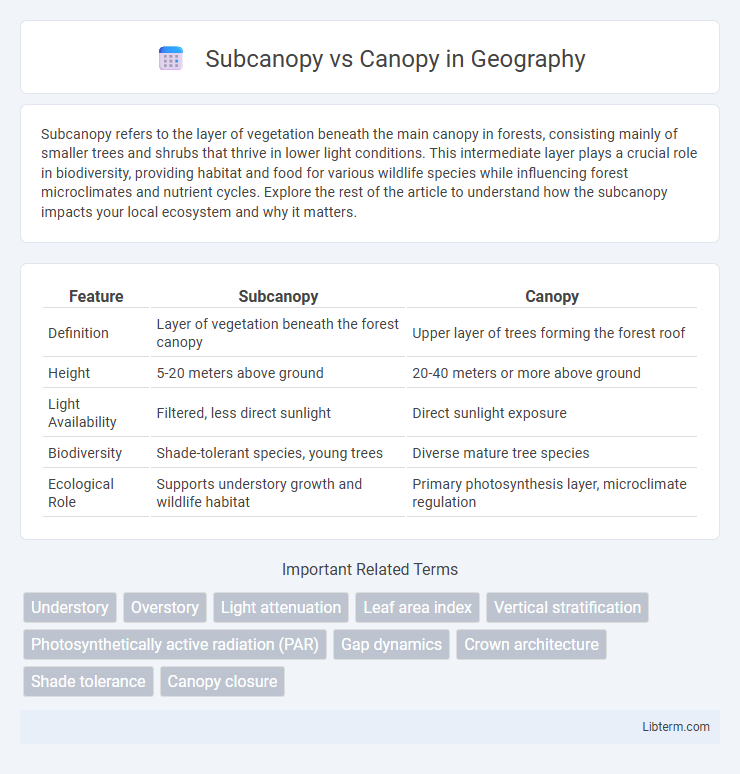Subcanopy refers to the layer of vegetation beneath the main canopy in forests, consisting mainly of smaller trees and shrubs that thrive in lower light conditions. This intermediate layer plays a crucial role in biodiversity, providing habitat and food for various wildlife species while influencing forest microclimates and nutrient cycles. Explore the rest of the article to understand how the subcanopy impacts your local ecosystem and why it matters.
Table of Comparison
| Feature | Subcanopy | Canopy |
|---|---|---|
| Definition | Layer of vegetation beneath the forest canopy | Upper layer of trees forming the forest roof |
| Height | 5-20 meters above ground | 20-40 meters or more above ground |
| Light Availability | Filtered, less direct sunlight | Direct sunlight exposure |
| Biodiversity | Shade-tolerant species, young trees | Diverse mature tree species |
| Ecological Role | Supports understory growth and wildlife habitat | Primary photosynthesis layer, microclimate regulation |
Introduction to Forest Stratification
Forest stratification organizes vegetation into distinct layers, with the canopy forming the uppermost layer dominated by tall, mature trees that receive the most sunlight. The subcanopy lies beneath, consisting of smaller, shade-tolerant trees and saplings adapted to lower light conditions. This vertical layering supports biodiversity by creating varied habitats and microclimates within a forest ecosystem.
What Is the Canopy Layer?
The canopy layer is the uppermost continuous layer of foliage in a forest that forms a dense roof of branches and leaves, capturing most of the sunlight for photosynthesis. It hosts a diverse range of flora and fauna, providing critical habitat and regulating the forest's microclimate. The subcanopy lies beneath the canopy layer, consisting of smaller trees and shrubs that thrive in filtered light conditions.
Defining the Subcanopy Layer
The subcanopy layer consists of smaller trees and shrubs growing beneath the main forest canopy, receiving filtered sunlight through the upper canopy leaves. This layer plays a crucial role in forest ecology by providing habitat for diverse wildlife and contributing to nutrient cycling. It acts as a transition zone influencing microclimate conditions and supporting species adapted to lower light levels.
Structural Differences: Canopy vs Subcanopy
The canopy consists of the uppermost layer of trees forming the forest roof, characterized by tall, mature trees with dense foliage that capture most sunlight and provide habitat for diverse wildlife. The subcanopy lies beneath the canopy, composed of shorter, younger trees and shrubs adapted to lower light conditions with less dense leaves and thinner branches. Structurally, the canopy supports a complex, interwoven network of branches and leaves, while the subcanopy offers a more open and layered arrangement, serving as a transitional zone between the forest floor and the upper canopy layer.
Light Availability and Photosynthesis
The canopy layer receives the highest light availability, facilitating maximum photosynthesis and energy production in trees due to direct sunlight exposure. In contrast, the subcanopy experiences reduced light intensity, limiting photosynthetic rates and often causing plants to adapt with larger, thinner leaves to capture available light efficiently. Variations in light penetration between these layers influence species distribution, growth strategies, and overall forest productivity.
Biodiversity in Canopy and Subcanopy
The biodiversity in the canopy includes a vast array of birds, insects, epiphytes, and arboreal mammals adapted to high light and airflow environments. The subcanopy hosts shade-tolerant plant species, smaller trees, and a diverse community of understory birds and insects that thrive in lower light and higher humidity. Together, the canopy and subcanopy layers form complementary habitats that support complex food webs and high species richness in forest ecosystems.
Ecological Roles of Each Layer
The canopy layer, composed primarily of mature, tall trees, plays a crucial role in regulating microclimates by providing shade and reducing temperature fluctuations, while also serving as a habitat for diverse wildlife such as birds and insects. The subcanopy, consisting of younger or smaller trees and shrubs beneath the canopy, contributes to forest regeneration by supporting sapling growth and offering shelter for species adapted to lower light conditions. Both layers interact to maintain biodiversity, nutrient cycling, and ecosystem stability within forest environments.
Species Adaptations: Canopy vs Subcanopy
Species in the canopy exhibit adaptations such as large leaves and robust structures to maximize light absorption and withstand strong winds, while subcanopy species tend to have broader, thinner leaves optimized for low-light conditions and efficient moisture retention. Canopy trees often develop thicker, waxy cuticles to prevent water loss and support epiphytes, whereas subcanopy plants feature flexible stems and shade tolerance for survival under dense overhead foliage. These distinct morphological and physiological traits enable species to thrive within their specific vertical niches in forest ecosystems.
Human Impact on Forest Layers
Human impact on forest layers significantly alters the subcanopy and canopy structure through activities like logging, urbanization, and agriculture. Canopy removal disrupts the microclimate, reducing light availability and changing temperature and humidity levels in the subcanopy, which affects biodiversity and plant regeneration. Fragmentation and selective cutting often lead to a simplified subcanopy composition, compromising the habitat for many understory species and diminishing overall forest resilience.
Conservation Importance of Both Layers
The subcanopy and canopy layers play crucial roles in forest ecosystems by supporting biodiversity and regulating microclimates. The canopy acts as the primary barrier that controls solar radiation, moisture retention, and wind levels, facilitating the habitat for a vast array of bird and insect species. The subcanopy provides essential refuges and food sources for understory wildlife, contributing to nutrient cycling and forest regeneration, making conservation efforts vital for preserving ecosystem resilience and species diversity.
Subcanopy Infographic

 libterm.com
libterm.com